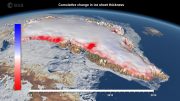
Researchers investigated if “dimming the sun” via geoengineering could prevent the melting of the West Antarctic ice sheet. Results indicate that while it might delay melting, the best long-term solution is rapid decarbonization, and geoengineering has high risks and potential unforeseen consequences.
Using geoengineering techniques, the climate could theoretically be artificially influenced and cooled.
Scientists from Bern have now explored the feasibility of halting the melting of the West Antarctic ice sheet through artificial solar dimming. Their findings indicate that artificial influence won’t work without decarbonization, and it comes with significant risks.
Is there an emergency solution that could stop climate change? Technical methods that artificially influence the climate have been discussed for some time under the term geoengineering. However, the majority of climate researchers have been critical of them: high risks, incalculable consequences for future generations.
In a study just published in the journal Nature Climate Change, researchers led by Johannes Sutter of the Climate and Environmental Physics Division (KUP) at the Institute of Physics and the Oeschger Center for Climate Research at the University of Bern investigate the question of whether the melting of ice in West Antarctica could be prevented by artificially influencing solar radiation. The researchers also warn of unforeseeable side effects of geoengineering.
Avoiding a key climate tipping point
“The window of opportunity to limit the global temperature increase to below 2 degrees is closing fast,” says ice modeling specialist Johannes Sutter, “so it is possible that technical measures to influence the climate will be seriously considered in the future.” That is why, he says, it is necessary to use theoretical models to study the effects and risks of “solar radiation management.” Solar Radiation Management (SRM) is a term used to describe various methods of blocking solar radiation in order to make the Earth cooler.
A key reason for the increased interest in geoengineering is the avoidance of tipping points at which the climate could change abruptly and irreversibly. These include the melting of the West Antarctic and Greenland ice sheets and the associated meter-high sea level rise. “Observations of ice flows in West Antarctica indicate that we are very close to a so-called tipping point or have already passed it,” explains Johannes Sutter, “with our study, we, therefore, wanted to find out whether a collapse of the ice sheet could theoretically be prevented with solar radiation management.”
Artificially dimming the sun
Specifically, Sutter and his colleagues have investigated what would happen if so-called aerosols – suspended particles in a gas – introduced into the stratosphere succeeded in blocking solar radiation from the earth – a dimming of the sun, so to speak. So far, research has focused on the global effects of solar radiation management (SRM). The Bern study is the first to use ice model simulations to show what effect such a measure would have on the Antarctic ice sheet. The study examines the possible development of the ice sheet under different future greenhouse gas scenarios and yields differentiated results: If emissions continue unabated and the SRM occurs in the middle of this century, the collapse of the West Antarctic Ice Sheet could be delayed somewhat, but not prevented. In a medium emissions scenario, SRM deployed by mid-century could prove to be an “effective tool” to slow or even prevent ice sheet collapse.
According to the model calculations, SRM works best when it occurs as early as possible and is combined with ambitious climate mitigation measures. But, the study authors emphasize, “Our simulations show that the most effective way to prevent the long-term collapse of the West Antarctic Ice Sheet is rapid decarbonization.” The chances of a longer-term stable ice sheet are greatest if greenhouse gas emissions were reduced to net zero “without delay.”
Possible side effects are still hardly studied
But how should one imagine a dimming of the sun in practical terms? According to Johannes Sutter, a whole fleet of extremely high-flying airplanes would have to spread millions of tons of aerosols in the stratosphere. However, this technical intervention in the climate would have to be maintained without interruption and for centuries. If the intervention were stopped as long as the greenhouse concentration in the atmosphere remained high, the temperature on Earth would quickly rise by several degrees.
The consequences of such a termination shock, Johannes Sutter points out, are only one of the possible dangers posed by SRM. The potential side effects are still insufficiently researched and range from a shift in the monsoon regime to changes in ocean and atmospheric circulation. Ocean acidification would also continue. Critical voices also caution against political and social effects: The use of techniques such as solar dimming could lead to climate protection measures being slowed down or even prevented.
Thomas Stocker, professor of climate and environmental physics at the University of Bern and co-author of the study, says: “Geoengineering would be another global experiment and a potentially dangerous human intervention in the climate system, which should in any case be prevented according to Article 2 of the UN Framework Convention on Climate Change.”
Reference: “Climate intervention on a high-emissions pathway could delay but not prevent West Antarctic Ice Sheet demise” by J. Sutter, A. Jones, T. L. Frölicher, C. Wirths and T. F. Stocker, 10 August 2023, Nature Climate Change.
DOI: 10.1038/s41558-023-01738-w








Dimming the sun will impact the ENTIRE Earth, not just West Antarctica. Why is it that West Antarctica is a concern and East Antarctica isn’t? There are good reasons to believe that geothermal heating at the base of the ice sheets is responsible for the melting. Dimming over the whole Earth may not stop the melting; meanwhile there is a risk that it might cool too much and plunge us back into a mini-Ice Age, with loss of crops and increased need for heating for survival.
“The best laid plans of mice and men often go astray.”
As the study authors say, the best solution is to stop CO2 emissions (fossil fuel use).
What could go wrong? EVERYTHING! Stupid humans.
No! No! No!
We’re told thew earth has been around for 4 billion years. We have less than 200 years of accurate climate data. The climate has changed dramatically over and over. Who comes up with these brainless ideas. I liken it to an old Three Stooges shows. Let me introduce you to the “Barren of Gray Matter.”
This is not about “dimming the sun” (reducing solar radiation) but about reducing the solar radiation reaching the earth’s surface.